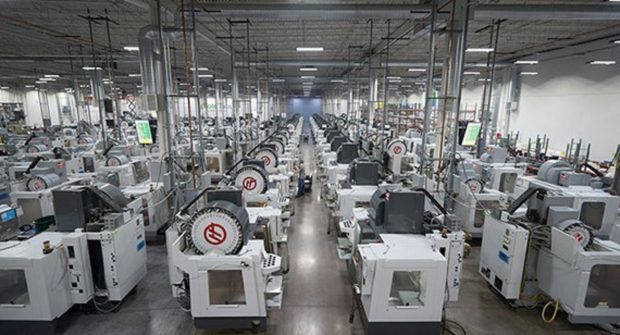Smart Manufacturing: How the Industrial Internet of Things is Enabling Factories of the Future

These milling machines, as well as similar arrays of injection molding presses and 3D printers, are connected to the Proto Labs network. Data collected by sensors track the progress of orders and help optimize scheduling. The monitor seen on the left displays real-time updates. Image courtesy of Proto Labs Inc.
Latest News
September 18, 2017
James Brown wasn’t thinking about manufacturing when he wrote “dig this crazy scene … his line is pretty clean … ain’t no drag, Papa’s got a brand new bag.” Manufacturing, deemed in terminal decline a decade ago, has a brand new bag. In “Smart Manufacturing: How the Industrial Internet of Things is Enabling Factories of the Future,” Proto Labs opens up manufacturing’s new bag to see what’s going on with this crazy new scene. It’s quite fascinating.
This blog feature article flatly asserts that digital manufacturing has changed the production floor and the job market. Our machines — mills, presses, 3D printers and so on — have become specialized computers. Those who work with these systems are as likely to be engineers and software developers as they are traditional production floor technicians.
And coming online fast are new waves of IIoT (Industrial Internet of Things) devices communicating with one another to share, analyze and adapt to data in near real time. Designers and engineers leverage these data resources to develop new products, including customized products for niche markets or individual clients. The net effect of all this change is that manufacturing’s speed, intelligence, efficiency and competitiveness will continue to grow rapidly.
 These milling machines, as well as similar arrays of injection molding presses and 3D printers, are connected to the Proto Labs network. Data collected by sensors track the progress of orders and help optimize scheduling. The monitor seen on the left displays real-time updates. Image courtesy of Proto Labs Inc.
These milling machines, as well as similar arrays of injection molding presses and 3D printers, are connected to the Proto Labs network. Data collected by sensors track the progress of orders and help optimize scheduling. The monitor seen on the left displays real-time updates. Image courtesy of Proto Labs Inc.All fine and dandy. But is digital manufacturing working or mostly hype to move IIoT devices? This post argues it’s working right now. It backs its words with real-world examples, infographics and a video. Better still, it provides multiple links to third-party resources like manufacturing reports, business surveys, research studies and implementation guides.
Further buttressing the “now-ness” of this ongoing change, the post looks at Proto Labs itself as representative of digital manufacturing. (The article is derived from the company’s in-house publication, which you can download.)
Over the years Proto Labs has developed a workflow that digitally threads together machines, computing horsepower and human intelligence. The post outlines the framework of this multidisciplinary, human-to-machine and intermachine enterprise from first client contact to part shipping.
Larry Lukis probably wasn’t thinking IIoT when he founded Proto Labs in 1999. He just wanted to get injection-molded plastic prototypes faster. But he and others were developing clean, new digital manufacturing lines with no drag. As more IIoT capabilities come online, this crazy good scene can only improve. “Smart Manufacturing: How the Industrial Internet of Things is Enabling Factories of the Future” explains what’s in it for you. Click here to read it.
Thanks, Pal. – Lockwood
Anthony J. Lockwood
Editor at Large, DE
Subscribe to our FREE magazine, FREE email newsletters or both!
Latest News
About the Author
Anthony J. Lockwood is Digital Engineering’s founding editor. He is now retired. Contact him via [email protected].
Follow DE







